| 1 | Fatality rate: 60% |
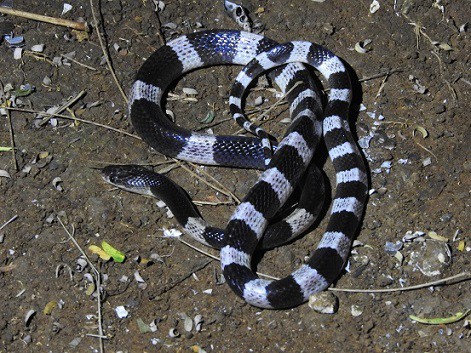
Thailand is one of the Earth’s greatest snake hubs, alongside Australia and Brazil. The country has over 230 species, and some argue that Bangkok is merely renting its territory from the snakes as opposed to vice versa (since the city was built on a marsh). One of the most feared is the Malaysian blue krait, AKA Bungarus candidus.
To explain in one sentence, this 100cm species kills 60-70% of victims who fail to receive medical care. Its venom has an extremely high LD50 score of 0.1mg in mice, outstripping the king cobra (0.9mg) with ease. Malaysian blue kraits are one of the most lethal species in Asia, and death generally comes within 12-24 hours.
In particular, this species has a neurotoxic venom rather than the skin-melting venom of a Chinese cobra. The precise cause of death is normally respiratory paralysis, as the lungs fail to inflate and deflate and deliver oxygen. Blue krait venom has two specific neurotoxin classes. The first is candoxin, a three finger toxin which creates a neuromuscular blockade, a barrier between brain and muscles leading to total muscular shutdown. Like other Asian kraits (members of the Bungarus family), it’s also rich in bungarotoxins, and specifically Alpha-bungarotoxin N3.
| 2 | Painless, undetectable bites |
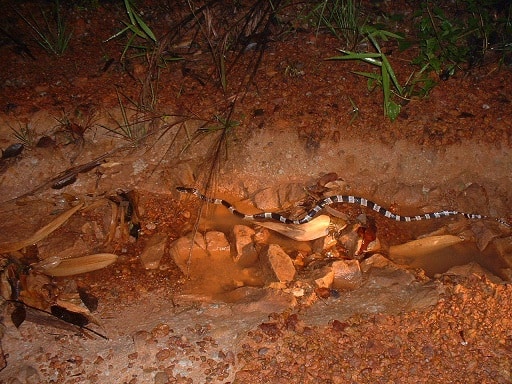
One of the most terrifying blue krait facts is that bites are almost impossible to detect. The venom produces no pain, little swelling, and no necrosis of the surrounding flesh. This is the exact opposite of the skin-corroding monocled cobra that lives nearby. It’s very possible to be bitten by a blue krait while sleeping, and wake up not realising that a 6 hour countdown to death is hanging over your head.
The happy flipside is that victims usually make a full recovery – if they survive. Being primarily neurotoxic, there’s no risk of life-changing amputations or corroded flesh like the black spitting cobra. The tough task is making it through the other side.
Thailand has two other kraits of the Bungarus family, Bungarus fasciatus (banded krait), and Bungarus flaviceps (red-headed krait). A study from 2018 analysed 78 krait bites from the Ramathibodi Poison Centre in Bangkok, over a 9 year period. Of the 6.4% of patients that died (all of whom received antivenom), all were bitten by blue kraits.
| 3 | Strikes without warning |
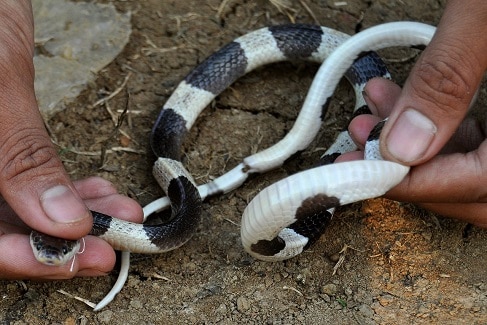
The blue krait is something of a silent assassin, as it’s notorious for skipping the traditional defensive warning postures. There’s no flared hood, piercing hiss or bluff strikes which only bash you in the stomach with this snake (unlike the Chinese cobra). Once they’ve made their decision, a blue krait will go to war with you with full commitment.
When resting, blue kraits are fairly calm, and can stand a lot of hassle before finally lunging. They’re less aggressive than the vicious trinket snake of Indian rice fields, which doesn’t even have venom.
The danger comes at night, when they enter hunting mode, searching for small snakes. Night is when the blue krait comes alive, transforming into a bogeyman from your darkest dreams. Their aggression rises, and they’ll causally bite any humans they slither past, who usually don’t notice them. Blue kraits often invade villages, and the most threatened are villages directly adjacent to forests, the species’ natural habitat.
| 4 | Specialises in lung failure |
One example of a bite happened in 1983, in the Chantaburi region of eastern Thailand. A 13 year old boy was sleeping on the floor of his hut at 3am, when a 1.1 metre blue krait bit him on the thigh. Medical teams swooped into action immediately, and within 30 minutes, the wound was very lightly swollen, with minimal redness and pain.
3 hours later, he had arrived at a local health station, but was already barely able to breath. His eyelids were drooping (ptosis), and he was unable to open his mouth or swallow. The doctors gave the boy 20ml of a general snake antivenom, but 7 hours post bite, he was on a breathing ventilator, and so paralysed that he could only communicate with doctors by twitching a finger or thumb. Even the boy’s gag reflex had deactivated, and his pulse had reached 120 beats per minute. Despite those symptoms, the bite mark still wasn’t swollen and only showed an imprint of fangs.
The boy endured, and starting on day 3, he regained the ability to move his eyes horizontally. His muscles gradually came back to life, and by day 14, he was back in action with no lasting symptoms.
| 5 | A fatal bite report |
Our second, less happy example occurred at the exact same time of night: 3am. She was lying on the floor of her rice mill in Chantaburi (also the same province), and thought that the sharp pain came from a skink lizard. Noticing only a slight bleeding, the woman went back to sleep. But 30 minutes later, she woke up feeling breathless, and with the bitten foot completely numb.
35 minutes later, she reached the hospital and was already unable to open her mouth, with her breathlessness worsening. Her blood pressure was normal, but she was now experiencing ptosis (drooping eyelids) and tachycardia (a heartrate of 100BPM plus). 2 hours post bite, she could still talk, but complained of blurred vision and rapidly spreading numbness.
Things went downhill 2 hours later, when the woman suffered respiratory and cardiac arrest. The doctor managed to revive her and placed her on artificial ventilation. At 14 hours, all that was visible was a single puncture mark on her toe. 3 days later, she died at the age of 44, with the diagnosis being anoxic brain injury.
The message: take no chances with black and white striped snakes in Thailand and the surrounding countries.
| 6 | Not actually blue |
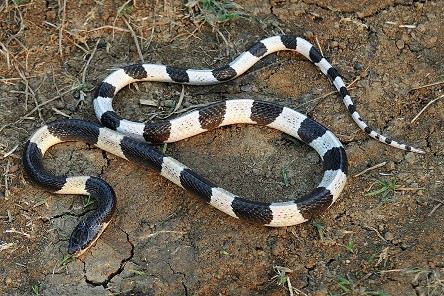
Malaysian blue kraits are a memorable snake, not brown and nondescript like a Japanese mamushi. They’re not actually blue, but covered with evenly spaced black and white columns. These are the only colours, except for a tiny minority where the white scales turn yellow towards the head. The black scales are pure black, while each white section has a tiny splashing of black spots at its centre.
These patterns extend to the head (a relatively small head), and the belly is a more consistent white. Those further north are different to the south: the white stripes are thinner, with black covering more area. Every so often, a pure black Bungarus candidus will be spotted, but this tends to be random.
Malaysian blue snakes range from 100 to 155cm, and their eyes have round pupils rather than cat-like vertical slits. They’re easy to distinguish from the closely related banded krait, as the latter is yellow and black instead. Occasionally, banded kraits will veer towards white, but their stumpy tail is another clear sign, compared to the thin, tapering tail of a blue krait.
| 7 | Beware – many mimics |
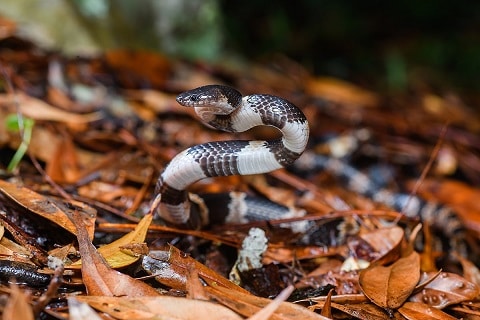
Because of the Malaysian blue krait’s sheer deadliness, the surrounding snakes have begun mimicking it to scare away predators, a tactic called Batesian mimicry. By far the trickiest is the harmless banded wolf snake (Lycodon subcinctus). The precise shades of the black and white columns are almost indistinguishable, the head is similarly small, and the body shape is just as slender. Even the beady black eyes are similar.
The only hope for a layman is in the spacing of the black and white stripes. In the blue krait, they’re spaced almost evenly, whereas the wolf snake has smaller white stripes and larger black zones. The problem is that northern blue krait colonies also have this altered spacing.
Another ID key, and one harder to spot, is a ridge of enlarged scales on the blue krait’s spine. It’s best just to retreat, but luckily, this is a misidentification that would save your life anyway.
| 8 | Strolls into towns and villages |
The official blue krait habitat is deciduous and dry evergreen forests, but they’re also drawn to villages and even university campuses like a magnet. They’re notorious for fulfilling everyone’s nightmares and slithering up drainpipes, sometimes appearing in cool bathrooms while people are brushing their teeth at 11pm.
In 2019, scientists tracked a single blue krait for 102 days starting on July 8th, making 117 observations. One day, a group of university students were gathered around a concrete drainage gutter, as the krait envenomated and began to devour a banded kukri snake. Paranoid security guards seized the blue krait, before the scientists arrived and assured everyone that all was under control. They then moved the krait to a forest edge 85 metres away, and dropped the dead kukri snake for it to gobble up.
To their surprise, they found the blue krait in the same university dorm burrow the very next day. The krait was so attracted to the campus that it had retraced its steps, all with a belly full of snake.
| 9 | Deliberately lurks in shadow |
On August 13th 2019, the scientists witnessed their blue krait hunting in action. Still in the university campus, it spent two hours prowling a sidewalk, poking its head into cracks in the concrete and walls, searching for smaller snakes to flush out. For most of the two hours, it was hidden in sheer darkness, in a blind spot the streetlights didn’t cover.
Oblivious students were milling around everywhere, most wearing flip flops and shorts, many with their eyes glued to phones. Some students came within metres of the highly venomous snake, forcing the scientists to halt and divert them. The krait wasn’t spooked by the crowds and constant sound of chattering one iota.
Another weird incident involved a snake hook, which the scientists had used to handle other snakes. The hook was resting against a wall, and when the blue krait caught its smell, its eyes widened, it span 180 degrees, and fled instantly down a burrow. Apparently, there are some snakes even the Malaysian blue krait is unnerved by.
| 10 | Diet: primarily other snakes |
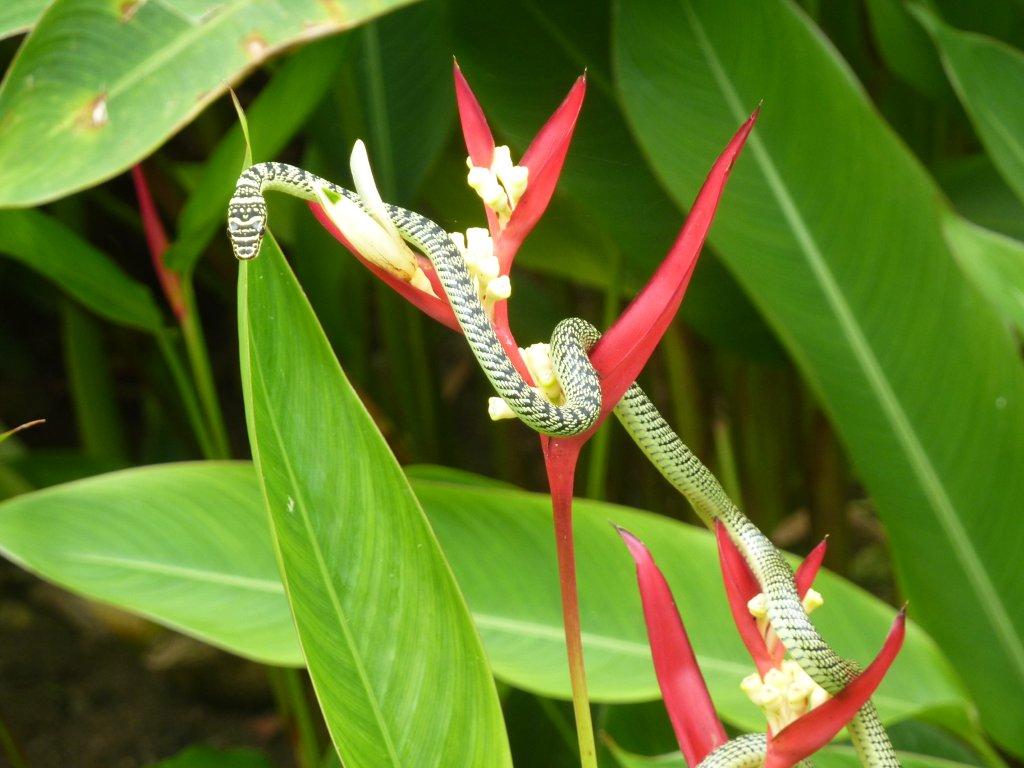
If a Malaysian blue krait can wipe out 60-70% of humans, then small animals will be no worry. This snake is flexible, and can eat rodents, frogs and lizards, but most of its calories come from other snakes. It normally takes them 5 minutes to swallow the dead snake from start to finish. Away from towns, blue kraits like to lurk in termite mounds, where they lie in wait for the insect-eating Brahminy’s blind snake (Indotyphlops braminus).
Small-banded kukri snakes are another staple (as confirmed in the university study), an olive-brown snake with no venom, which measures 1.1 metres and dines on toads. Radiated ratsnakes are on the menu, as are golden tree snakes, one of the 5 iconic flying species.
Blue kraits rarely appear in trees, while golden tree snakes cling to high branches, but both are common home invaders, and this is where they meet. In 2019, a blue krait was spotted devouring a golden tree snake on the brown-tiled floor of a university laboratory. As usual, it took 5 minutes to be fully swallowed.
